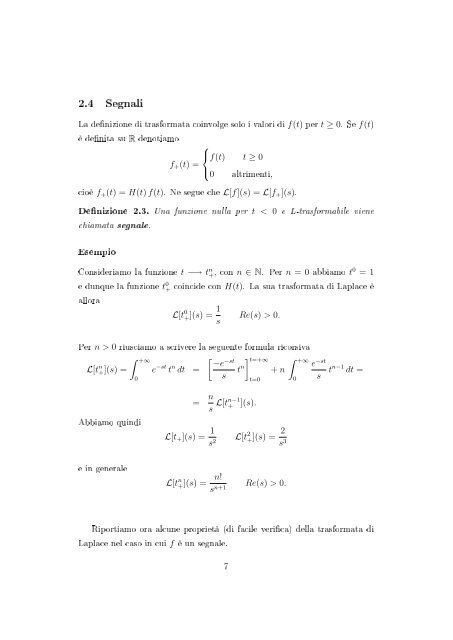1 La trasformata di Laplace
1 La trasformata di Laplace
1 La trasformata di Laplace
- No tags were found...
Create successful ePaper yourself
Turn your PDF publications into a flip-book with our unique Google optimized e-Paper software.
2.4 Segnali<strong>La</strong> denizione <strong>di</strong> <strong>trasformata</strong> coinvolge solo i valori <strong>di</strong> f(t) per t ≥ 0. Se f(t)è denita su R denotiamo⎧⎨f(t) t ≥ 0f + (t) =⎩0 altrimenti,cioè f + (t) = H(t) f(t). Ne segue che L[f](s) = L[f + ](s).Denizione 2.3. Una funzione nulla per t < 0 e L-trasformabile vienechiamata segnale.EsempioConsideriamo la funzione t −→ t n +, con n ∈ N. Per n = 0 abbiamo t 0 = 1e dunque la funzione t 0 + coincide con H(t). <strong>La</strong> sua <strong>trasformata</strong> <strong>di</strong> <strong>La</strong>place èalloraL[t 0 +](s) = 1 Re(s) > 0.sPer n > 0 riusciamo a scrivere la seguente formula ricorsiva∫ +∞[ ] −eL[t n +](s) = e −st t n −st t=+∞ ∫ +∞dt = t n + ns0Abbiamo quin<strong>di</strong>t=0= n s L[tn−1 + ](s).L[t + ](s) = 1 s 2 L[t 2 +](s) = 2 s 30e −sts tn−1 dt =e in generaleL[t n +](s) = n!s n+1 Re(s) > 0.Riportiamo ora alcune proprietà (<strong>di</strong> facile verica) della <strong>trasformata</strong> <strong>di</strong><strong>La</strong>place nel caso in cui f è un segnale.7
















